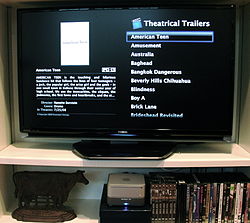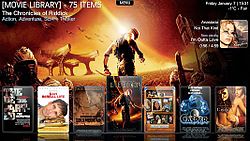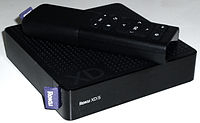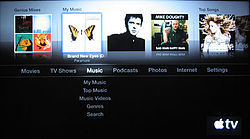- Home theater PC
-
A Home Theater PC (HTPC) or Media Center appliance is a convergence device that combines some or all the capabilities of a personal computer with a software application that supports video, photo, music playback, and sometimes video recording functionality. Although computers with some of these capabilities were available from the late 1980s, the "Home Theater PC" term first appeared in mainstream press in 1996. In recent years, other types of consumer electronics, including gaming systems and dedicated media devices have crossed over to manage video and music content. The term "media center" also refers to specialized application software designed to run on standard personal computers.[1]
An HTPC and other convergence devices integrate components of a home theater into a unit co-located with a home entertainment system. An HTPC system typically has a remote control and the software interface normally has a 10-foot user interface design so that it can be comfortably viewed at typical television viewing distances. An HTPC can be purchased pre-configured with the required hardware and software needed to add video programming or music to the PC. Enthusiasts can also piece together a system out of discrete components as part of a software-based HTPC.[1][2][3][4][5]
Since 2007 digital media receiver software has been incorporated into consumer electronics through software or hardware changes including gaming systems, blu-ray players, televisions, and set top boxes. The increased availability of specialized devices, coupled with paid and free digital content, now offer alternatives to multipurpose (and more costly) personal computers.[6]
Contents
History
The HTPC is the product of several technology innovations including high-powered home computers, digital media, and the shift from standard resolution CRT to high definition monitors and projectors.
Integrating televisions and personal computers dates back to the late 1980s with tuner cards that could be added to Commodore Amiga PCs via the Video Toaster. This adaptation would allow a small video window to appear on the screen with broadcast or cable content. Apple Computer also developed the Macintosh TV in late 1993 that included a tuner card built into an Macintosh LC 520 chassis but quickly withdrew from the market with only 10,000 units shipped.[7][8]
In 1996 Gateway Computer unveiled the Destination computer that included a tuner card, video card. The unit cost $4,000 and mostly integrated television viewing and computer functions on one color monitor.[7] The Destination was called a "PC-TV Combo" but by December the term "Home-theater PC" appeared in mainstream media: "The home theater PC will be a combination entertainment and information appliance".[9]
By 2000, DVD players had become relatively ubiquitous and consumers were seeking ways to improve the picture. The value of using a computer instead of stand alone DVD player drove more usage of the PC as a home media device. In particular, the desire for progressive scanning DVD players (480p instead of 480i) with better video fidelity led some consumers to consider their computers instead of very expensive DVD players.[10]
As DVD players dropped in price, so did PCs and their related video processing and storage capabilities. In 2000, DVD decryption software using the DeCSS algorithm let DVD owners consolidate their DVD video libraries on hard-drives.[11] Innovations like Tivo and ReplayTV allowed viewers to store and timeshift broadcast content using specialty designed computers. ReplayTV for instance ran on a VxWorks platform. Incorporating these capabilities into PCs was well within the ability of a computer hobbyist who was willing to build and program these systems. Key benefits of these DIY projects included lower cost and more features.[12] Advancements in hardware identified another weak link: the absence of media management software to make it easy to display and control the video from a distance.[10]
By 2002, major software developments also facilitated media management, hardware integration, and content presentation. MythTV provided a free and open source solution using Linux. The concept was to combine a digital tuner with digital video recording, program guides, and computer capabilities with a 10-foot user interface.[13] XBMC was another free and open software project started with re-purposing the Xbox as a home theater PC but has since been ported to Windows and Macintosh operating systems in various forms including Boxee and Plex.[14] Mainstream commercial software packages included Microsoft's XP Media Center Edition (2002) that was bundled with Windows XP and Apple's Front Row (2005) software bundled with Mac OS X. By early 2006, commercial examples of this integration included the Mac mini which had the Apple Remote, 5.1 digital audio, and an updated Front Row interface that would play shared media. Because of these features and the Mini's small form factor, consumers began using the Mini as a Mac-based home theater PC.[15]
As digital cable and satellite became the norm, HTPC software became more dependent on external decoder boxes, and the subscription costs that came with them. For instance, MythTV is capable of capturing unencrypted HDTV streams, such as those broadcast over the air or on cable using a QAM tuner. However, most U.S. cable and satellite set-top boxes provide only encrypted HD streams for "non-basic" content, which can be decoded only by OpenCable-approved hardware or software.[16][17] In September 2009, OEM restrictions were officially lifted for cableCARD devices,[18] opening up the possibility for HTPC integration.[19]
The advent of the fully digital HDTV displays helped to complete the value and ease of use of a HTPC system. Digital projectors, plasma and LCD displays often came pre-configured to accept computer video outputs including VGA, DVI and Component Video. Furthermore, both the computers and the displays could include video scalers to better conform the image to the screen format and resolutions. Likewise, computers also included HDMI ports that carry both audio and video signals to home video displays or AV Receivers.
The simplified integration of computer and home theater displays has allowed for fully digital content distribution over the internet. For instance, by 2007 Netflix "watch instantly" subscribers could view streaming content using their HTPCs with a browser[20] or with plug-ins with applications like Boxee, Plex, and XBMC. Similar plug-in are also available for Hulu, YouTube, and broadcasters like NBC, CBS and PBS.[21]
HTPC characteristics
 Antec Fusion V2 home theater PC case with VFD display, 5.25" drive bay, volume control and some ports on front and keyboard on top.
Antec Fusion V2 home theater PC case with VFD display, 5.25" drive bay, volume control and some ports on front and keyboard on top.
 Home theater PC keyboard with additional media control buttons
Home theater PC keyboard with additional media control buttons
The media itself may be stored, received by terrestrial, satellite or cable broadcasting or streamed from the internet. Stored media is kept either on a local hard drive or on a (wireless) network attached storage. Some software is capable of doing other tasks, such as finding news (RSS) from the Internet.
Beyond functioning as a standard PC, normally HTPCs have some additional characteristics:
Television connectivity
Standard PC units are usually connected to a CRT or LCD display, while HTPCs are designed to be connected to a television. All HTPCs should feature a TV-out option, using either a HDMI, DVI, DisplayPort, Component video, VGA (for some LCD televisions), S-Video, or Composite video output.[22]
Remote control
Integrating a HTPC into a typical living room requires a way of controlling it from a distance. Many TV tuner/capture cards include remote controls for use with the applications included with the card. Software such as Boxee, GB-PVR, SageTV, MediaPortal and Beyond TV support the use of Windows MCE and other remote controls. Another option is an in-air mouse pointer like the Wii Remote, GlideTV Navigator, or Loop Pointer which gives cursor control from a distance. It is also possible to utilize common wireless keyboards and other peripherals to achieve the same effect (though the range may not be as long as a typical remote control).[22]
External and networked storage devices
Because of the nature of the HTPC, higher than average capacities are required for HTPC units to allow storage of pictures, music, television shows, videos, and other multimedia.[22] Designed almost as a 'permanent storage' device, space can quickly run out on these devices. Because of restrictions on internal space for hard disc drives and a desire for low noise levels, many HTPC units utilize a NAS (Network Attached Storage) device, or another type of network connected file server.[3]
TV tuner cards
A TV tuner card is a computer component that allows television signals to be received by a computer. Most TV tuners also function as video capture cards, allowing them to record television programs onto a hard disk. Several manufacturers build combined TV tuner plus capture cards for PCs. Many such cards offer hardware MPEG encoding to reduce the computing requirements. Some cards are designed for analog TV signals such as standard definition cable or off the air television, while others are designed for high definition digital TV.[22]
Quiet / minimal noise
See also: Quiet PCA common user complaint with using standard PCs as HTPC units is background noise, especially in quieter film scenes. Most personal computers are designed for maximum performance, while the functions of a HTPC system may not be processor-intensive. Thus, passive cooling systems, low-speed fans, vibration-absorbing elastic mounts for fans and hard drives, and other noise-minimizing devices are used in place of conventional cooling systems.[22]
Keeping the media on a separate file server elsewhere in the home keeps the noise and heat generated by a hard drive in another location.
Software
HTPC options exist for each of the major operating systems: Microsoft Windows, Mac OS X and Linux. The software is sometimes called "Media Center Software".
GNU/Linux
For GNU/Linux, there exist a few options. Mythbuntu is a special derivative of Ubuntu Desktop Edition which uses MythTV, just as XBMC Live is a special derivative of Ubuntu Mobile Edition which uses XBMC Media Center, while LinuxMCE combines MythTV and the Kubuntu distribution. KnoppMyth combines the Knoppix Linux distribution with MythTV, a Linux based software PVR. SageTV provides commercially supported Linux HTPC software that is compatible with most major Linux distributions. Another option is Mythdora which combines MythTV with Fedora. Boxee provides free media center software on their website which is based on XBMC. Boxee adds social features which allow users to rank content and to broadcast information about their viewing habits to other users. The Boxee software is also used to power the Boxee Box.
OpenELEC is an extremely small and very fast booting Linux based distribution providing a complete media center software suite that comes with a pre-configured version of XBMC and third-party addons with retro video game console emulators and PVR plugins.
Element OS is a Xubuntu based distribution built for HTPCs. It uses a specially modified version of Xfce designed to be used at the high resolutions HTPCs often use. It comes with XBMC pre-installed, but boxee, hulu, or moovida can easily be installed. There is currently very limited PVR functionality in Element OS, this functionality was expected to be enhanced in later versions however Element OS has been discontinued and is no longer available.
There is also VDR - quite popular software PVR with many available plugins, good performance and HDTV support.[2][3][4]
Mac OS X
 The Mac mini with OS X has a small footprint, remote control and HDMI output that is well suited for HTPC applications.[23]
The Mac mini with OS X has a small footprint, remote control and HDMI output that is well suited for HTPC applications.[23]
For Mac OS X, some HTPC functionality is built into the operating system itself. Specifically, the programs Front Row and Cover Flow, utilized in conjunction with the Apple Remote, let users easily browse through and view any multimedia content stored on their Macs.[15]
Several third-party applications provide HTPC support including Plex,[24] Boxee and XBMC.[25]
Beyond the operating system itself, add-on hardware-plus-software combinations (for adding more full-featured HTPC abilities to any Mac) include Elgato's EyeTV series PVRs,[25] AMD's "ATI Wonder" external USB 2.0 TV-tuners, and various individual devices from third-party manufacturers.
Microsoft Windows
For Microsoft Windows, a common approach is to install a version that contains the Windows Media Center (Home Premium, Professional or Ultimate for Windows 7, Home Premium or Ultimate for Windows Vista, or the older Windows XP Media Center Edition). Windows Media Center includes additional software that covers the PVR functions of the proposed HTPC, including free program guide information and automatic program recording. Windows 7, Windows Vista Home Premium and Windows Vista Ultimate already include an MPEG2 decoder.[2][3][4] Only Windows XP MCE does not provide an MPEG2 codec, that can be purchased from Intel, or is alternatively included in Intervideo's WinDVD shareware, or with DVD Decoder packages such as Nvidia's PureVideo and Sonic's CinePlayer.
Alternative HTPC software may be built with the addition of a third party software PVR to a Windows PC. SageTV and GB-PVR have integrated placeshifting comparable to the Slingbox, allowing client PCs and the Hauppauge MediaMVP to be connected to the server over the network. Snapstream provides heuristic commercial detection and program recompression. When using a faster CPU, SageTV and Beyond TV can record content from TV capture cards which do not include hardware MPEG2 compression. For a free alternative, GB-PVR and MediaPortal provide full home theater support and good multi-card DVR capabilities. GB-PVR also has a free client, free mediaMVP client, and free network media playback. MediaPortal provides a full Client/Server set-up with Live TV / DVR (Recorded or Timeshifted) streaming. MediaPortal is open source and offers a variety of skins and plugins for Music Videos, Netflix, Pandora and others.[2][3][4][26]
Digital media receivers and consumer electronics integration
Although digital media receivers are often built using similar components to personal computers, they are often smaller, quieter and less costly than the full-featured computers adapted to multi-media entertainment.[6]
In recent years, convergence devices for home entertainment including gaming systems, DVRs, Blu-Ray Players and dedicated devices like the Roku have also started managing local video, music, and/or streaming internet content. Likewise, some managed video services like Verizon's FiOS allow users to incorporate their photographs, video, and music from their personal computers to their FiOS set-top-box including DVRs.[29] Gaming systems like the Nintendo Wii,[30] Sony PlayStation 3[31] and the Microsoft Xbox 360[32][33] support media management beyond their original gaming orientation.
As computing power increases and costs fall, traditional media devices like televisions have been given network capabilities. So-called Smart TVs from Sony, Samsung, and Vizio (to name a few) have models that allow owners to include some free or subscription media content available on the Internet.[34] The rapid growth in the availability of online content, including music and video and games has also made it easier for consumers use these networked devices. Youtube, for instance, is a common plug-in available on most networked devices. Netflix has also struck deals with many consumer electronics makers to have their interface available for their streaming subscribers. This symbiotic relationship between Netflix and consumer electronics makers has helped propel Netflix to become the largest subscription video service in the U.S.,[35] using up to 20% of U.S. bandwidth at peak times.[36]
Other digital media retailers like Apple, Amazon.com and Blockbuster have purchase and rental options for video and music on demand. Apple in particular has developed a tightly integrated device and content management ecosystem with their iTunes store, personal computers, iOS devices, and the AppleTV digital media receiver.[37] The most recent version of the AppleTV, at $99, has lost the hard-drive that was included in its predecessor and fully depends on either streaming internet content, or another computer on the home network for media.[38]
Impact on traditional television services
The convergence of content, technology, and broadband access allows consumers to stream television shows and movies to their high-definition television in competition with traditional service providers (Cable TV and Satellite Television). The research company SNL Kagan expects 12 million households, roughly 10%, to go without cable, satellite or telco video service by 2015 using Over The Top services.[39] This represents a new trend in the broadcast television industry, as the list of options for watching movies and TV over the Internet grows every day. Research also shows that even as traditional television service providers are trimming their customer base, they are adding Broadband Internet customers. Nearly 76.6 million U.S. households get broadband from leading cable and telephone companies,[40] although only a portion have sufficient speeds to support quality video steaming.[41] Convergence devices for home entertainment will likely play a much larger role in the future of broadcast television, effectively shifting traditional revenue streams while providing consumers with more options.[41]
See also
- Comparison of PVR software packages
- Comparison of set-top boxes
- Digital video recorder
- Digital media receiver
- Home cinema
- Media server
- Portable media player
- Skin
References
- ^ a b Won, Brian (2010-12-01). "Ars Technica HTPC Guide: December 2010". Ars Technica. http://arstechnica.com/gadgets/guides/2010/12/htpc-guide-1. Retrieved February 12, 2010.
- ^ a b c d Won, Brian (2008-12-01). "Ars Ultimate Home Theater PC Guide: 1080p HDMI Edition". Ars Technica. http://arstechnica.com/hardware/guides/2008/12/guide-200812-htpc.ars. Retrieved February 12, 2010.
- ^ a b c d e Jason Fitzpatrick & Kevin Purdy (2010-02-02). "Which Media Center Is Right for You: Boxee, XBMC, and Windows Media Center Compared". Lifehacker. http://lifehacker.com/5462275/which-media-center-is-right-for-you-boxee-xbmc-and-windows-media-center-compared. Retrieved February 12, 2010.
- ^ a b c d Adam Pash (2008-12-07). "Five Best Media Center Applications". Lifehacker. http://lifehacker.com/5103464/five-best-media-center-applications. Retrieved February 12, 2010.
- ^ http://www.engadget.com/2011/06/13/acer-ships-amd-powered-revo-rl100-htpc-to-americans-499-and-up/ Acer ships AMD-powered Revo RL100 HTPC to Americans: $499 and up
- ^ a b Brown, Michael (2010-09-07). "Can a Media Player Replace a Home Theater PC?". Maximum PC. http://www.maximumpc.com/article/features/can_media_player_replace_home_theater_pc. Retrieved February 14, 2011.
- ^ a b Elstrom, Peter (March 25, 1996). "Gateway's Destination: Your Living Room". Business Week. http://www.businessweek.com/1996/13/b3468128.htm. Retrieved February 4, 2010.
- ^ "Macintosh 500 Series". Low End Mac.com. http://lowendmac.com/500/macintosh-tv.html. Retrieved February 4, 2010.
- ^ "Digital TV Standard Endorsed by FCC". Contra Costa Times. December 27, 1996. http://www.google.com/search?q=%22Home+Theater+PC%22&ie=utf-8&oe=utf-8&aq=t&rls=org.mozilla:en-US:official&client=firefox-a#q=%22Home+Theater+PC%22&hl=en&safe=off&client=firefox-a&hs=8TD&sa=X&rls=org.mozilla:en-US:official&tbs=tl:1,tll:1996/12,tlh:1996/12&prmd=ivns&ei=YQw5Tv-cDoTWgQfblOXPBg&ved=0CEwQzQEwAQ&bav=on.2,or.r_gc.r_pw.&fp=4cafd6e9feb08560&biw=1440&bih=740. Retrieved August 3, 2011.
- ^ a b Kessler, Andrew J. (July 24, 2000). "Parameters". Forbes Magazine. http://www.forbes.com/forbes/2000/0724/6603210a.html. Retrieved February 8, 2010.
- ^ In a 2007 landmark ruling, a U.S. court found this practice legal in specific applications where the CSS encryption is transferred to the copy on the hard drive in spite of the Digital Millennium Copyright Act. Bangeman, Eric (March 29, 2007). "DVD consortium loses court case over DVD copying". Ars Technica. http://arstechnica.com/tech-policy/news/2007/03/dvd-consortium-loses-court-case-over-dvd-copying.ars. Retrieved February 12, 2010.
- ^ Dang, Alan (November 28, 2007). "The Trouble with HTPCs". www.firingsquad.com. http://www.firingsquad.com/hardware/trouble_with_htpc/. Retrieved February 8, 2010.
- ^ Barylick, Chris (2006-03-26). "MythTV Invades Realm of Cable and TiVo". The Washington Post. http://www.washingtonpost.com/wp-dyn/content/article/2006/03/25/AR2006032500115.html. Retrieved 2010-02-19.
- ^ Spagnolo, Giovani (July 10, 2009). "FLOSS Media Centers State of the Art Comparison Chart". Telematics Freedom Foundation. http://static.telematicsfreedom.org/flossmediacenter/EN_FLOSS_Media_Center_Comparison.pdf. Retrieved February 9, 2010.
- ^ a b Breen, Christopher (May 31, 2006). "My multimedia Mac mini". Macworld. http://www.macworld.com/article/51113/2006/05/multimediamini.html. Retrieved February 8, 2010.
- ^ "GeekTonic: Will CableCard Support Ever Arrive for BeyondTV, Sage or MythTV?". geektonic.com. April 7, 2007. http://www.geektonic.com/2007/04/will-cablecard-support-ever-come-for.html. Retrieved May 2, 2011.
- ^ Lanier, Chris (February 6, 2007). "OS X and Linux: CableCARD, DIRECTV, Dish, HD DVD, Blu-ray?". MSMVPs.com. http://msmvps.com/blogs/chrisl/archive/2007/02/06/549593.aspx. Retrieved May 2, 2011.
- ^ Kim, Stephen (September 9, 2009). "Media Center CableCARDs freed from OEM requirement". Engadget. http://hd.engadget.com/2009/09/09/media-center-cablecards-freed-from-oem-requirement/. Retrieved February 8, 2010.
- ^ Drawbaugh, Ben (May 12, 2009). "How to install a CableCARD tuner in your DIY Media Center". Engadget. http://hd.engadget.com/2009/05/12/how-to-install-a-cablecard-tuner-in-your-diy-media-center/. Retrieved February 8, 2010.
- ^ Topolsky, Joshua. "Netflix finally brings 'Watch Instantly' to Macs via Silverlight - Engadget". Engadget.com. http://www.engadget.com/2008/10/26/netflix-finally-brings-watch-instantly-to-macs-via-silverlight/. Retrieved 2008-11-21.
- ^ Anderson, Nate (August 2007). "Opinion: the HTPC is dead; long live the HTPC". Ars Technica. http://arstechnica.com/hardware/news/2008/07/opinion-the-htpc-is-dead-long-live-the-htpc.ars. Retrieved February 11, 2010.
- ^ a b c d e "HTPC vs. PC, Top 10 Differences". http://www.hometheaternetwork.com/HTN_HTPC2b.htm. Retrieved February 13, 2010.
- ^ Eaton, Kit (June 15, 2010), Apple's New Mac Mini: A Preview of the Next Apple TV, Fast Company, http://www.fastcompany.com/1660215/apple-mac-mini-tv-unibody-osx-ios-computers-design, retrieved February 14, 2011
- ^ Vähäkainu, Matti (2008-10-12). "Plex media player hands-on". Afterdawn.com. http://www.afterdawn.com/news/archive/15933.cfm. Retrieved 2009-10-31.
- ^ a b Breen, Christopher (April 22, 2009). "Mac mini media center: Get content". Macworld. http://www.macworld.com/article/140090/2009/04/macmini_mediacenter_content.html. Retrieved February 12, 2010.
- ^ http://www.engadget.com/2011/06/18/sage-tv-htpc-software-acquired-by-google-next-stop-google-tv/ SageTV HTPC software acquired by Google, next stop Google TV?
- ^ "Roku XDS (2100X) Review". Cnet. 2010-12-02. http://reviews.cnet.com/digital-media-receivers/roku-xds-2100x/4505-6739_7-34182627.html#reviewPage1. Retrieved 2011-02-13.
- ^ Horsey, Jillian (May 4, 2011). "Plex Media Now Available On Roku". Geeky Gadgets.com. http://www.geeky-gadgets.com/plex-media-now-available-on-roku-04-05-2011/n. Retrieved May 12, 2011.
- ^ Verizon FiOS TV: What is Media Manager, Verizon, http://www22.verizon.com/residentialhelp/fiostv/guide/enhanced+tv/questionsone/124941.htm, retrieved September 2, 2010
- ^ "Nintendo Wii debuts disc-free Netflix streaming". http://news.cnet.com/8301-13506_3-20019842-17.html.
- ^ Moran, Nancy (April 21, 2008). "Sony to Offer Online Video Over PlayStation, L.A. Times Reports". Bloomberg. http://www.bloomberg.com/apps/news?pid=newsarchive&sid=aRKwM5L7aX2s&refer=japan. Retrieved February 10, 2011.
- ^ Joystiq (2007-07-27). HD-Streaming: Guide For Streaming HD To The Xbox360. http://www.joystiq.com/2006/11/07/how-to-transcode-and-stream-videos-on-xbox-360/. Retrieved 2011-02-08.
- ^ "Xbox 360 to show Sky live and on-demand programming". Reuters. 2009-05-28. http://www.reuters.com/article/rbssTechMediaTelecomNews/idUSLS97781220090528. Retrieved 2011-02-08.
- ^ Yuhnke, Kirk (January 20, 2011). "TVs get smart with Internet access in 2011". ABC 15, Arizona. http://www.abc15.com/dpp/news/science_tech/tvs-get-smart-with-internet-access-in-2011. Retrieved February 9, 2011.
- ^ Narcisse, Evan (April 25, 2011). "Netflix Becoming Largest Subscription Entertainment Company". Time (magazine). http://techland.time.com/2011/04/25/netflix-becoming-largest-subscription-entertainment-company/. Retrieved May 2, 2011.
- ^ Liedtke, Michael (November 22, 2010). "Netflix expects video streaming to drown out DVDs". Associated Press. http://www.valleynewslive.com/Global/story.asp?S=13551980&clienttype=printable. Retrieved February 7, 2011.
- ^ Elmer-DeWitt, Philip (2010-10-01). "How Apple took the high ground in the battle for the global digital living room". Fortune. http://tech.fortune.cnn.com/2010/10/01/how-apple-took-the-high-ground-in-the-battle-for-the-global-digital-living-room/. Retrieved 2011-02-13.
- ^ Lynch, Brendan (2011-01-24). "Apple’s Web TV packs big bang for the buck". Boston Herald. http://www.bostonherald.com/business/technology/reviews/view/20110124apples_web_tv_packs_big_bang_for_the_buck/srvc=home&position=also. Retrieved 2011-02-08.
- ^ "12 Million Households Expected to Cut the Cord By 2015". Forbes. 2011-07-20. http://blogs.forbes.com/dorothypomerantz/2011/07/20/12-million-households-expected-to-cut-the-cord-by-2015. Retrieved 2011-07-20.
- ^ "Nearly 1.3 Million Add Broadband in the First Quarter of 2011". Leichtman Research Group. 2011-05-17. http://leichtmanresearch.com/press/051711release.html. Retrieved 2011-05-17.
- ^ a b McQuivey, Ph.D., James L. (2011-03-14). "Online Video On TV Leads To Cord-Cutting By 2012". Forrester Research. http://www.forrester.com/rb/Research/online_video_on_tv_leads_to_cord-cutting/q/id/57160/t/2/. Retrieved 2011-07-22.
External links
- Time to Get a Home Theater PC
- Guide to Building a Home Theater PC - Updated Monthly
- Differences between HTPC and PC
Categories:- Personal computers
- Multimedia
- Personal computing
Wikimedia Foundation. 2010.






